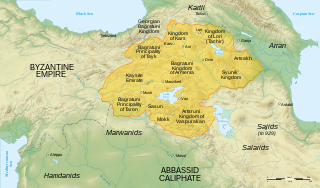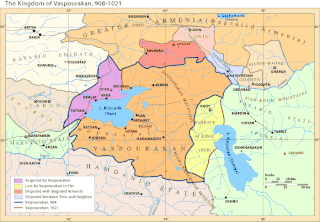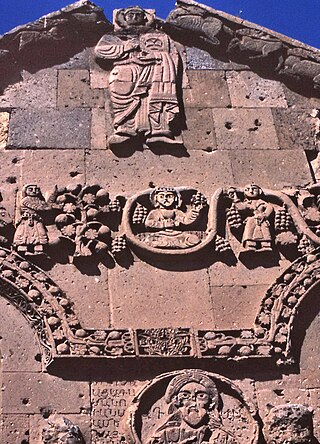Related Research Articles

Van is a mostly Kurdish-populated and historically Armenian-populated city in eastern Turkey's Van Province. The city lies on the eastern shore of Lake Van.
Andzevatsik, or Andzevatciq was a region of ancient and medieval Armenia c. 400–800 in the South-East of Vaspurakan, ruled by the Antzevatsi family.
The Principality of Anjewaci or Andzewatsi, was an Armenian dynasty of Median or Carduchian ancestry, who ruled in an eponymous region in southern Armenia. It was located in southeast of Lake Van and northwest of Ake and centered at the castle of Kangvar.

The Artsruni were an ancient noble (princely) family of Armenia.
Amatuni is an ancient Armenian noble family, known from the 4th century in the canton of Artaz, between lakes Van and Urmia, with its center at Shavarshan, and subsequently also at Aragatsotn, west of Lake Sevan, with the residence at Oshakan.
The Armenian nobility was a class of persons which enjoyed certain privileges relative to other members of society under the laws and customs of various regimes of Armenia. Governments which recognized or conferred nobility were the Kingdom of Van, Satrapy of Armenia, Kingdom of Armenia, Bagratid Kingdom of Armenia (885-1045) and the Armenian Kingdom of Cilicia (1198-1375). The Armenian kingdoms of Vanand (963-1065), Syunik (987-1170), and Lori (978-1113) had a system of nobility that was similar to the nobility of Cilicia.
Vaspurakan was the eighth province of the ancient kingdom of Armenia, which later became an independent kingdom during the Middle Ages, centered on Lake Van. Located in what is now southeastern Turkey and northwestern Iran, the region is considered to be the cradle of Armenian civilization.

Tushpa was the 9th-century BC capital of Urartu, later becoming known as Van which is derived from Biainili, the native name of Urartu. The ancient ruins are located just west of Van and east of Lake Van in the Van Province of Turkey. In 2016 it was inscribed in the Tentative list of World Heritage Sites in Turkey.
The Shah-Armens, also known as Ahlatshahs, was a Turkmen Sunni Muslim Anatolian beylik founded after the Battle of Manzikert (1071) and centred in Ahlat on the northwestern shore of the Lake Van. This region comprised most of modern-day Bitlis and Van, and parts of Muş provinces.

The Bagratid Kingdom of Armenia, also known as Bagratid Armenia, was an independent Armenian state established by Ashot I Bagratuni of the Bagratuni dynasty in the early 880s following nearly two centuries of foreign domination of Greater Armenia under Arab Umayyad and Abbasid rule. With each of the two contemporary powers in the region—the Abbasids and Byzantines—too preoccupied to concentrate their forces in subjugating the region, and with the dissipation of several of the Armenian nakharar noble families, Ashot succeeded in asserting himself as the leading figure of a movement to dislodge the Arabs from Armenia.

The Kaysite dynasty was a Muslim Arab dynasty that ruled an emirate centered in Manzikert from c. 860 until 964. Their state was the most powerful Arab amirate in Armenia after the collapse of the ostikanate of Arminiya in the late 9th century.

Karmravank is an abandoned 10th century Armenian monastery in the Vaspurakan province of historic Armenia. It was founded by King Gagik I (908-943) of the Artsruni dynasty. It is located 12 kilometers west-northwest of Akhtamar Island.

The Kingdom of Vaspurakan was a medieval Armenian kingdom centered on Lake Van, located in what is now eastern Turkey and northwestern Iran. It was named after Vaspurakan, a province of historic Greater Armenia. Ruled by the Artsruni dynasty, it competed and cooperated with the Bagratuni-ruled Kingdom of Armenia for a little over a century until its last king ceded the kingdom to the Byzantine Empire in 1021.
Mardpetakan was a historical region and principality within the province of Vaspurakan of Armenia. It stretched in between the principality of Andzewatsʻi in Corduene, south of Lake Van, to Siunik, north of Araxes river.

Gagik I Artsruni was an Armenian noble of the Artsruni dynasty who ruled over Vaspurakan in southern Armenia, first as prince of northwestern Vaspurakan and after that until his death as King of Vaspurakan, also claiming the title of King of Armenia.
Senekerim-Hovhannes Artsruni, also known variously as Senekerim-John, Sennecherim or Sennacherib-John, known in Byzantine sources simply as Senachereim, was the sixth and last King of Vaspurakan, from the Artsruni dynasty. In 1021/22, he surrendered his kingdom to the Byzantine emperor Basil II, receiving in return extensive lands in the Empire, and the governorship of Cappadocia.

The Bagratuni or Bagratid dynasty was an Armenian royal dynasty which ruled the medieval Kingdom of Armenia from c. 885 until 1045. Originating as vassals of the Kingdom of Armenia of antiquity, they rose to become the most prominent Armenian noble family during the period of Arab rule in Armenia, eventually establishing their own independent kingdom. Their domain included regions of Armenia such as Shirak, Bagrevand, Kogovit, Syunik, Lori, Vaspurakan, Vanand and Taron. Many historians, such as Cyril Toumanoff, Nicholas Adontz and Ronald Suny, consider them to be the progenitors of the Georgian royal Bagrationi dynasty.
The Principality of Hamamshen was a small principality established in about 790 by Armenians who fled the Arab invasions of Armenia and the creation of the Muslim Arab ruled state of Arminiya.

Nikephoros Komnenos was a Byzantine military leader under the emperors Basil II and Constantine VIII. He served as governor of the Armenian region of Vaspurakan, and is one of the first known members of the Komnenos family, which came to rule the Byzantine Empire in 1081–1185.
The Bagratuni family tree describes the heritage of the Bagratuni family in Armenia and Georgia.